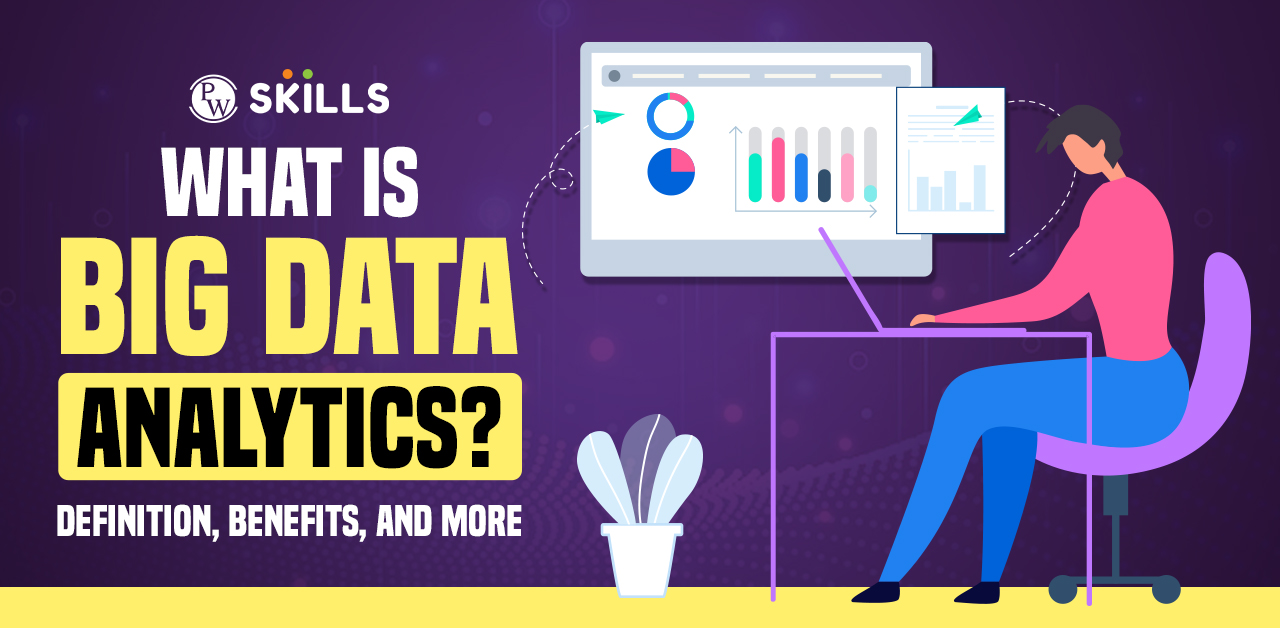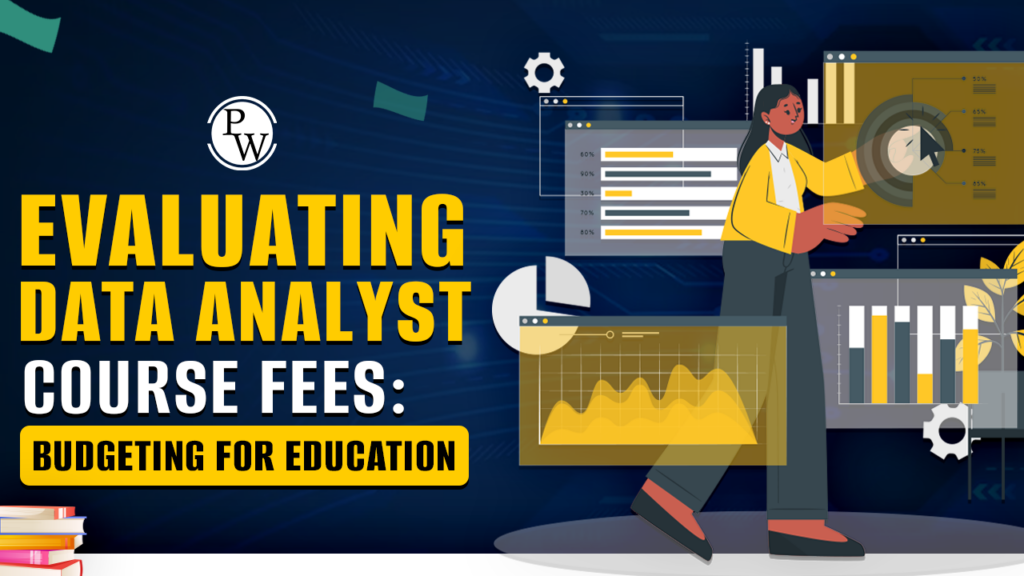Big data analytics is the process of identifying trends, patterns, and correlations in vast amounts of raw data in order to make data-informed decisions. Keep reading to know more!
Big Data Analytics: In today’s digital age, the amount of data being generated on a daily basis is staggering. From social media interactions and online transactions to IoT devices and sensor networks, the sheer volume of data being collected is surpassing what traditional data processing methods can handle. This is where Big Data analytics comes into play.

The right courses and resources can help individuals and companies harness the power of big data analytics effectively. This is where we highly recommend the Data Analytics Course offered by Physics Wallah. Plus, by using the coupon code “READER,” you can get a discount on this already affordable course.
What is Meant by Big Data Analytics?
Big Data analytics is the process of extracting valuable insights from large amounts of data, such as hidden patterns, unknown relationships, market trends, and customer preferences. Traditional databases often struggle with the massive size or diverse types of data involved in this process. Hence, specialized tools and techniques are employed to manage and process this data efficiently.
History of Big Data Analytics
The roots of Big Data analytics can be traced back to the initial phases of computing, where businesses started leveraging computer systems to store and process extensive data sets. However, the true momentum for Big Data analytics surged in the late 1990s and early 2000s.
During this period, businesses increasingly relied on computer-driven solutions to decipher the burgeoning volumes of data generated by their operations.
In the contemporary landscape, Big Data analytics stands as a cornerstone for organizations spanning diverse sectors and sizes. By tapping into the potential of Big Data, businesses can unearth invaluable insights about their clientele, operational facets, and the broader environment, transcending previous limitations.
Looking ahead, as the realm of Big Data analytics undergoes continual advancements, the horizon appears promising with prospects for groundbreaking applications and innovations in the forthcoming years.
Big Data Analytics Tools
In the rapidly evolving realm of data analytics, the tools available for processing, managing, and deriving insights from vast datasets continue to expand. These tools empower organizations to extract valuable insights, optimize operations, and drive informed decision-making. Here’s a detailed exploration of some prominent Big Data Analytics tools:
1) Hadoop:
- Overview: Hadoop is an open-source framework renowned for its capability to store and process extensive datasets across distributed computing clusters.
- Features: It excels in handling both structured and unstructured data, providing scalability, fault tolerance, and robust data processing capabilities. Hadoop’s core components include the Hadoop Distributed File System (HDFS) for storage and MapReduce for data processing.
2) Spark:
- Overview: Apache Spark is a powerful open-source, distributed computing framework designed for rapid data processing and analytics.
- Features: Spark facilitates real-time data processing, machine learning, graph processing, and stream processing. Its in-memory data processing capability accelerates data analytics tasks, making it highly efficient for complex data operations.
3) Data Integration Software:
- Overview: Data integration software enables seamless data integration and interoperability across diverse platforms and data sources.
- Examples: MongoDB, Apache Hadoop, and Amazon EMR are popular data integration tools that simplify data management, facilitate data transformation, and enhance data accessibility across distributed systems.
4) Stream Analytics Tools (e.g., Kafka):
- Overview: Stream analytics tools enable organizations to process and analyze real-time streaming data from various sources.
- Features: Kafka, for instance, is a distributed streaming platform that facilitates high-throughput, fault-tolerant processing of real-time data streams. It excels in handling massive volumes of data, ensuring data durability, and supporting real-time analytics applications.
5) Distributed Storage (e.g., Cassandra):
- Overview: Distributed storage systems distribute data across multiple servers or nodes, ensuring data availability, fault tolerance, and scalability.
- Features: Cassandra, a NoSQL database, is renowned for its distributed architecture, high availability, and ability to manage vast amounts of structured and unstructured data across multiple nodes, ensuring optimal performance and reliability.
6) Predictive Analytics Tools:
- Overview: Predictive analytics tools leverage machine learning algorithms and statistical techniques to analyze historical data and forecast future trends, behaviors, and outcomes.
- Applications: These tools are instrumental in various domains, including fraud detection, customer segmentation, risk assessment, and marketing campaign optimization, by predicting future patterns and enabling proactive decision-making.
7) Data Mining Tools:
- Overview: Data mining tools facilitate the exploration and analysis of vast datasets to identify patterns, correlations, and insights that drive organizational strategies and initiatives.
- Features: These tools employ advanced algorithms and techniques to uncover hidden patterns, trends, and relationships within structured and unstructured data, enabling businesses to gain a competitive edge through data-driven insights.
8) NoSQL Databases & Data Warehouses:
- Overview: NoSQL databases and data warehouses serve as pivotal repositories for storing, managing, and analyzing vast volumes of structured and unstructured data.
- Features: While NoSQL databases like MongoDB offer flexible schema design, horizontal scalability, and efficient data retrieval, data warehouses like Amazon Redshift provide robust storage, advanced querying capabilities, and optimized performance for analytics workloads, ensuring seamless data management and analysis.
How Does Big Data Analytics Work?
Big Data Analytics is an intricate process that allows organizations to derive meaningful insights from vast and varied data sets. Here’s a detailed breakdown of how this complex mechanism operates:
1) Data Collection:
The journey begins with data collection from a myriad of sources. These sources encompass a mix of structured, semi-structured, and unstructured data types. Some primary sources include:
- Internet clickstream data: Captures user interactions on websites.
- Web server logs: Records activities on web servers.
- Cloud applications: Data generated from cloud-based platforms.
- Mobile applications: Information gleaned from mobile apps.
- Social media content: Insights from platforms like Twitter, Facebook, etc.
- Customer communications: Texts from emails, feedback forms, and surveys.
- Mobile phone records: Data from call logs, messages, and app usage.
- IoT sensors: Machine data captured by devices connected to the Internet of Things.
2) Data Preparation and Processing:
Once collected, the raw data needs refinement for meaningful analysis. It’s stored in data warehouses or data lakes. The processing involves:
- Organizing and Configuring: Structuring the data for efficient querying.
- Partitioning: Dividing data into segments to enhance performance.
- Batch and Stream Processing: Large datasets may be processed in batches over time, while stream processing allows for real-time or near-real-time analysis, speeding up insights generation.
3) Data Cleansing:
Ensuring data quality is paramount. Data professionals employ tools to cleanse data by:
- Identifying Errors: Detecting duplications, inconsistencies, or inaccuracies.
- Formatting: Standardizing data formats for uniformity.
- Eliminating Redundancies: Removing repeated or unnecessary data elements.
4) Data Analysis:
The crux of Big Data Analytics lies in analyzing cleansed data using a suite of advanced tools and techniques:
- Data Mining: This involves exploring vast datasets to uncover hidden patterns or relationships.
- Predictive Analytics: Employing models to anticipate future behaviors, trends, or outcomes based on historical data.
- Machine Learning: Utilizing algorithms that enable systems to learn from data and improve over time without explicit programming.
- Deep Learning: A subset of machine learning that mimics the workings of the human brain to process data and create patterns for decision-making.
- Text Mining: Extracting valuable information from textual data sources.
- Statistical Analysis: Applying statistical methods to evaluate and interpret data.
- Artificial Intelligence: Using algorithms and models to simulate intelligent behavior.
- Business Intelligence Software: Leveraging mainstream BI tools to visualize and interpret data for strategic decision-making.
Big Data Analytics Examples
Here are some real-world examples that illustrate how Big Data Analytics has been implemented across various industries:
1) Healthcare:
- Patient Monitoring: Hospitals and healthcare providers use Big Data Analytics to monitor patient vitals in real-time. For instance, wearable devices can track heart rates, blood pressure, and other vital statistics, providing early warnings of potential health issues.
- Disease Prediction: By analyzing historical patient data, healthcare organizations can predict disease outbreaks, identify high-risk populations, and allocate resources effectively, as demonstrated during the COVID-19 pandemic.
2) Retail:
- Customer Personalization: Retail giants like Amazon utilize Big Data Analytics to personalize user experiences. By analyzing customers’ browsing history, purchase behavior, and preferences, they recommend products tailored to individual users, enhancing customer satisfaction and boosting sales.
- Inventory Management: Retailers leverage Big Data Analytics to optimize inventory levels, predict demand fluctuations, and minimize stockouts or overstocks, thereby improving operational efficiency and profitability.
3) Finance:
- Fraud Detection: Financial institutions employ Big Data Analytics to detect fraudulent activities. By analyzing transaction patterns, user behavior, and historical data, banks can identify and prevent unauthorized transactions in real-time.
- Risk Assessment: Insurance companies utilize Big Data Analytics to assess risks accurately. By analyzing customers’ profiles, historical claims data, and external factors, insurers can price policies effectively and mitigate potential losses.
4) Transportation:
- Traffic Management: City planners and transportation authorities use Big Data Analytics to manage traffic congestion effectively. By analyzing real-time traffic data, road conditions, and weather forecasts, they can optimize traffic light timings, reroute traffic, and improve overall traffic flow.
- Predictive Maintenance: Airlines and railway companies leverage Big Data Analytics to perform predictive maintenance. By analyzing equipment sensor data, maintenance records, and operational metrics, they can identify potential issues before they escalate, ensuring safety and minimizing downtime.
5) Entertainment:
- Content Recommendation: Streaming platforms like Netflix and Spotify utilize Big Data Analytics to recommend content to users. By analyzing viewers’ watch history, preferences, and ratings, they personalize content recommendations, enhancing user engagement and retention.
- Audience Insights: Media companies analyze viewership data, social media trends, and audience demographics using Big Data Analytics to understand viewer preferences, tailor content, and develop targeted advertising campaigns.
6) Manufacturing:
- Supply Chain Optimization: Manufacturing companies employ Big Data Analytics to optimize their supply chains. By analyzing supplier performance, inventory levels, demand forecasts, and production schedules, they can minimize lead times, reduce costs, and enhance operational efficiency.
- Quality Control: Manufacturers use Big Data Analytics to improve product quality and reduce defects. By analyzing production data, equipment sensor readings, and quality inspection results, they can identify defects early in the production process, ensuring product reliability and customer satisfaction.
Also Read: Data Analysis Techniques in Research: Methods, Tools, Examples
Why is Big Data Analytics Important?
Big Data Analytics is of paramount importance in today’s digital age for a multitude of reasons:
- Big Data Analytics provides organizations with insights derived from vast and varied datasets. These insights enable businesses to make data-driven decisions rather than relying solely on intuition or historical trends. By understanding customer behaviors, market trends, and operational efficiencies, companies can strategize better and optimize their performance.
- In industries saturated with competition, leveraging Big Data Analytics can provide a competitive edge. By extracting meaningful patterns and trends from data, businesses can identify market opportunities, anticipate customer needs, and innovate faster than competitors.
- Understanding customer preferences, behaviors, and sentiments is crucial in today’s customer-centric landscape. Big Data Analytics enables organizations to personalize marketing campaigns, tailor products or services, and improve customer service, leading to heightened customer satisfaction and loyalty.
- Big Data Analytics helps organizations streamline operations by identifying inefficiencies, optimizing processes, and reducing costs. Whether it’s supply chain management, resource allocation, or inventory optimization, data-driven insights enable businesses to operate more efficiently and effectively.
- By analyzing vast datasets, organizations can identify potential risks, whether they are related to financial fluctuations, cybersecurity threats, or regulatory compliance. Predictive analytics, a subset of Big Data Analytics, allows businesses to anticipate and mitigate risks proactively, safeguarding their assets and reputation.
- Big Data Analytics provides invaluable insights into market demands, customer preferences, and emerging trends. This information is instrumental in driving innovation, developing new products or services, and enhancing existing offerings based on real-time feedback and evolving market dynamics.
- With the proliferation of digital channels and platforms, personalizing interactions has become imperative. Big Data Analytics enables businesses to segment their audience effectively, deliver targeted marketing campaigns, and create personalized experiences, thereby maximizing engagement and conversion rates.
- As organizations grow and evolve, their data requirements and analytical needs change. Big Data Analytics platforms offer scalability, allowing businesses to handle increasing data volumes, diverse data types, and evolving analytical models efficiently. Moreover, cloud-based analytics solutions provide flexibility, enabling organizations to adapt to changing business requirements seamlessly.
Big Data Analytics is pivotal in driving strategic decision-making, fostering innovation, enhancing customer experiences, and maintaining competitive advantages in today’s dynamic and data-driven business landscape. Embracing Big Data Analytics is not merely an option but a necessity for organizations aspiring to thrive and succeed in the digital era.
Also Read: How to Analyze Survey Data: Methods & Examples
Types of Big Data Analytics
Big Data Analytics encompasses a spectrum of methodologies tailored to extract insights from vast and complex datasets. Here’s a comprehensive breakdown of the distinct types of big data analytics:
1) Descriptive Analytics:
- Overview: Descriptive analytics offers a foundational understanding by summarizing historical data to generate reports and visual representations. It provides a snapshot of what has occurred in a business or system.
- Example: A multinational retail chain leverages descriptive analytics to evaluate monthly sales performance across its global outlets, producing comprehensive reports that highlight top-performing regions and product categories.
2) Diagnostics Analytics:
- Overview: Diagnostics analytics delves deeper into data to uncover the root causes behind specific outcomes or anomalies. It emphasizes understanding the ‘why’ behind observed trends or events.
- Example: An e-commerce platform, noticing a decline in customer retention rates, employs diagnostics analytics to trace the issue to a recent website redesign that inadvertently complicated the user checkout process.
3) Predictive Analytics:
- Overview: Predictive analytics leverages historical and real-time data, combined with statistical algorithms and machine learning techniques, to forecast future trends, behaviors, or occurrences. It provides organizations with foresight, allowing proactive decision-making.
- Example: A telecommunications company utilizes predictive analytics to anticipate potential network congestions during major sporting events, ensuring they can allocate resources effectively to maintain service quality for customers.
4) Prescriptive Analytics:
- Overview: Prescriptive analytics goes beyond prediction by recommending actionable insights or strategies based on analyzed data. By leveraging advanced technologies like AI and machine learning, it not only forecasts potential outcomes but also suggests optimal actions to achieve desired objectives.
- Example: An airline company harnesses prescriptive analytics to optimize flight routes, considering factors such as fuel efficiency, weather patterns, and passenger demand, ensuring cost-effectiveness and customer satisfaction.
The Impact of Big Data Analytics Types:
- Descriptive analytics lays the groundwork, providing a comprehensive overview that informs subsequent analytical processes.
- Diagnostics analytics acts as a detective, identifying underlying causes and enabling organizations to rectify issues promptly, enhancing operational efficiency and customer satisfaction.
- Predictive analytics empowers organizations with foresight, enabling proactive strategies that capitalize on emerging opportunities and mitigate potential risks.
- Prescriptive analytics drives informed decision-making, offering actionable insights that optimize processes, resources, and outcomes, fostering innovation and competitive advantage.
In essence, each type of big data analytics serves a unique purpose, collectively empowering organizations to navigate the complexities of today’s data-driven landscape effectively.
Also Read: Quantitative Data Analysis: Types, Analysis & Examples
Benefits of Big Data Analytics
Big Data Analytics stands as a transformative force, providing a multitude of advantages across various sectors. Here’s an in-depth look at the key benefits:
1) Cost-Efficiency:
- Centralized Storage: With big data analytics, businesses can consolidate their vast amounts of data in one centralized location. This consolidation eliminates redundancy, reduces storage costs, and streamlines data management processes.
- Operational Efficiency: Through advanced analytics, organizations can identify inefficiencies in their operations, leading to optimized processes and reduced operational costs.
2) Enhanced Product Development:
- Customer-Centric Approach: By leveraging data analytics, businesses gain insights into consumer preferences, behaviors, and feedback. This knowledge facilitates the creation of products or services tailored to meet specific customer needs, ensuring higher market acceptance and success.
- Trend Identification: Big data analytics tools enable organizations to stay abreast of market trends, ensuring they remain competitive and innovative in their product offerings.
3) Strategic Decision-Making:
- Real-Time Insights: Big data analytics provides real-time data processing capabilities, enabling businesses to make timely and informed decisions. This agility is crucial in dynamically changing business environments, ensuring competitive advantage.
- Optimized Operations: With insights derived from data analytics, organizations can refine their supply chain, inventory management, and resource allocation strategies, driving operational excellence.
4) Enhanced Customer Experience:
- Personalization: Through data-driven insights, businesses can personalize customer interactions, from tailored marketing campaigns to customized product recommendations, fostering enhanced customer satisfaction and loyalty.
- Predictive Analytics: By leveraging predictive analytics, organizations can anticipate customer needs and preferences, enabling proactive service delivery and heightened customer experience.
5) Robust Risk Management:
- Risk Identification: Big data analytics empowers organizations to identify potential risks by analyzing data patterns and trends. This proactive approach enables businesses to devise effective risk mitigation strategies, safeguarding their operations and reputation.
Big Data Analytics emerges as a pivotal tool, driving innovation, efficiency, and strategic decision-making across industries, ultimately fostering growth, profitability, and enhanced customer satisfaction.
Explore Big Data Analytics With Physics Wallah
Big data analytics is a crucial tool in today’s digital world and has countless benefits for businesses and consumers alike.
From improving efficiency and decision-making to personalizing customer experiences, the potential of big data analytics is immense.
And as technology continues to advance and generate even larger volumes of data, the demand for skilled data analysts will only continue to grow. That’s why it’s important for individuals to educate themselves on this field and take advantage of opportunities such as the Data Analytics Course by Physics Wallah.
By learning the fundamentals of big data analytics from PW experts, you can gain the knowledge and skills needed to thrive in this industry. So don’t hesitate any longer, use the promo code “READER” during checkout to get a discount on this comprehensive course that will equip you with everything you need to know about big data analytics.
For Latest Tech Related Information, Join Our Official Free Telegram Group : PW Skills Telegram Group
Big Data Analytics FAQs
Why is big data analytics useful?
Big data analytics is useful because it helps organizations uncover insights, patterns, and trends from large data sets, enabling informed decision-making, enhancing operational efficiency, understanding customer behavior, and gaining competitive advantages.
What is an example of big data analytics?
An example of big data analytics is the healthcare sector using vast patient records, medical claims, and clinical outcomes to derive insights for better patient care, treatment predictions, and resource allocation.
What are the 3 types of big data?
The three types of big data are:
Structured Data: Organized and easily searchable data, like databases.
Semi-Structured Data: Contains both structured and unstructured components, like XML or JSON files.
Unstructured Data: Includes raw, unorganized data, such as text, images, videos, and social media posts.
What are the primary sources of Big Data?
The primary sources of Big Data include internet clickstream data, web server logs, cloud applications, mobile applications, social media content, customer communications (emails, surveys), mobile phone records, and data from Internet of Things (IoT) sensors.
Why is data cleansing essential in Big Data Analytics?
Data cleansing, or data cleaning, is crucial in Big Data Analytics as it ensures data accuracy, consistency, and reliability. By eliminating errors, redundancies, and inconsistencies, organizations can derive more accurate insights and make informed decisions.






